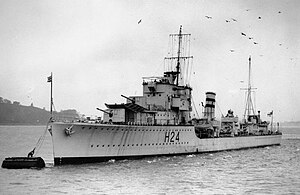
| |
| History | |
|---|---|
| Name | Havock |
| Builder | William Denny & Brothers, Dumbarton |
| Laid down | 15 May 1935 |
| Launched | July 1936 |
| Completed | 16 January 1937 |
| Identification | Pennant number: H43 |
| Fate | Ran aground and wrecked, 6 April 1942 |
| General characteristics as built | |
| Class and type | H-class destroyer |
| Displacement | |
| Length | 323 ft (98.5 m) |
| Beam | 33 ft (10.1 m) |
| Draught | 12 ft 5 in (3.8 m) |
| Installed power |
|
| Propulsion | 2 shafts, 2 geared steam turbines |
| Speed | 36 knots (67 km/h; 41 mph) |
| Range | 5,530 nmi (10,240 km; 6,360 mi) at 15 knots (28 km/h; 17 mph) |
| Complement | 137 (peacetime), 146 (wartime) |
| Sensors and processing systems | ASDIC |
| Armament |
|
HMS Havock was an H-class destroyer built for the British Royal Navy in the mid-1930s. During the Spanish Civil War of 1936–1939, the ship enforced the arms blockade imposed by Britain and France on both sides as part of the Mediterranean Fleet. During the first few months of the Second World War, Havock searched for German commerce raiders in the Atlantic Ocean and participated in the First Battle of Narvik during the Norwegian Campaign of April–June 1940 before she was transferred back to the Mediterranean Fleet in May where she escorted a number of convoys to Malta. The ship took part in the Battle of Cape Spada in July 1940, the Battle of Cape Matapan in March 1941 and the evacuation of Greece in April 1941. She was damaged during the Battle of Crete the following month, but participated in the Syria–Lebanon Campaign in June.
Havock began escorting supply convoys in June to Tobruk, Libya until the ship was damaged in October. She was repaired in time to escort a convoy to Malta during the First Battle of Sirte in December and was badly damaged by the Italian battleship Littorio whilst protecting another convoy during the Second Battle of Sirte in March 1942. Repairs were attempted in Malta, but the ship was further damaged in an air raid in early April. The Admiralty decided that further attempts to repair her at Malta were pointless and ordered her to Gibraltar for permanent repairs. On 6 April, while on passage to Gibraltar, Havock ran aground near Cape Bon, Tunisia, and her crew was interned by the Vichy French at Laghouat in the Sahara.